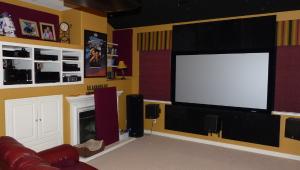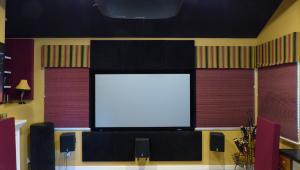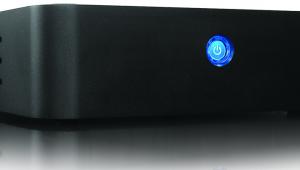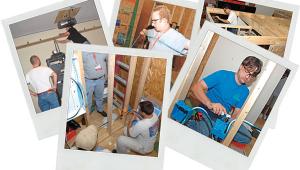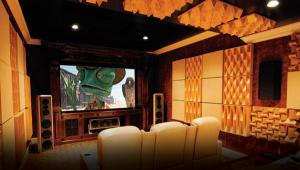Design the Ultimate Home Theater– On a Budget Page 4
 There are two types of acoustic-treatment materials: those that absorb sound and those that diffuse sound. Soft, fuzzy, porous, or resonant materials absorb sound and transform it into heat through friction of the fibers or trap it in their porous or resonant cavities. Diffusive materials preserve most of the sound's energy but reflect it in different directions. Many materials are both reflective and absorptive. For instance, a single layer of regular drywall mounted on two-by-four studs that are placed 16 inches on-center will absorb some sounds below 250 Hz but will reflect most frequencies above that point. One-inch-thick Fiberglas will absorb sound evenly down to about 1 kilohertz. It absorbs less sound between 1 kHz and 500 Hz and considerably less at lower frequencies.
There are two types of acoustic-treatment materials: those that absorb sound and those that diffuse sound. Soft, fuzzy, porous, or resonant materials absorb sound and transform it into heat through friction of the fibers or trap it in their porous or resonant cavities. Diffusive materials preserve most of the sound's energy but reflect it in different directions. Many materials are both reflective and absorptive. For instance, a single layer of regular drywall mounted on two-by-four studs that are placed 16 inches on-center will absorb some sounds below 250 Hz but will reflect most frequencies above that point. One-inch-thick Fiberglas will absorb sound evenly down to about 1 kilohertz. It absorbs less sound between 1 kHz and 500 Hz and considerably less at lower frequencies.
Lining your room's four walls with 1-inch-thick, fabric-wrapped acoustic panels is a common approach to acoustic treatment. However, all three of our experts consider this approach to be less than optimum. While it might eliminate slap echoes and first-order reflections, it also eliminates high-frequency energy and has little or no effect on mid-range and low frequencies. This gives you boomy, bloated sound that lacks sparkle and detail. Instead, consider using a few specially designed bass absorbers in combination with other treatments.
Diffusers are one such treatment. They usually consist of small blocks, curves, or slats placed at varied depths. More-expensive diffusers vary the depth of the blocks, curves, or slats according to mathematical formulae. These diffusers reflect sounds more evenly across the frequency spectrum. A flat, hard surface (like drywall) will reflect sound as well, but the majority of the sound's energy travels in one direction: away from the surface at an angle equal to the angle at which it hit the surface. A diffuser directs sound in multiple directions, with less sound traveling in any one direction. Placing diffusers across from flat surfaces can eliminate slap echoes. Locating diffusers at first-order-reflection points can attenuate the reflection without losing the sound's energy. A stacked bookshelf can be a good diffuser, but only if you place the books at varied depths.
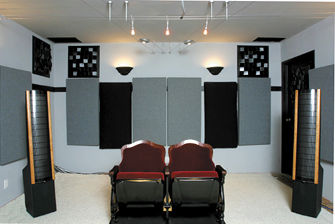
Even in 14 pages, there are a number of things I've glossed over for the sake of space. For descriptions of these and other acoustic techniques, see the third edition of F. Alton Everest's book The Master Handbook of Acoustics. (According to Russ, you should get the second or third edition, since there are numerous math errors in the fourth edition.) Or, you could just hire one of our experts. Hopefully, with the information we've provided, you'll at least be able to tell if the person you hire knows what he or she is talking about.

